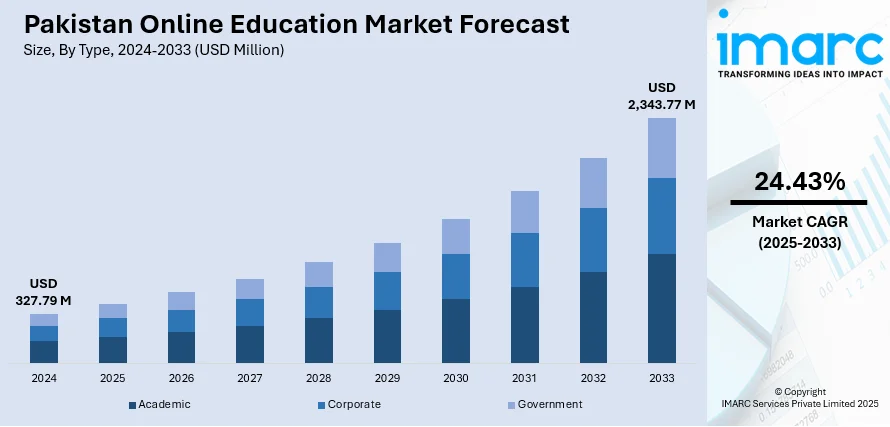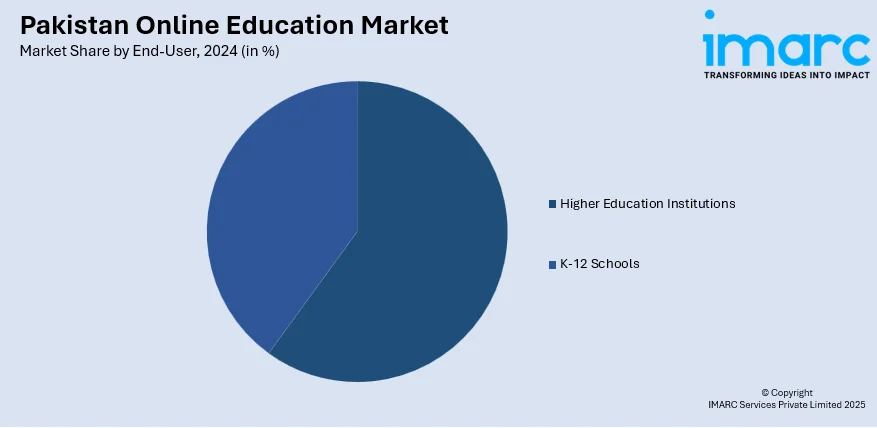
Pakistan Online Education Market Size, Share, Trends and Forecast by Type, Provider, Technology, End-User, and Province, 2025-2033
Pakistan Online Education Market Overview:
The Pakistan online education market size reached USD 327.79 Million in 2024. Looking forward, the market is expected to reach USD 2,343.77 Million by 2033, exhibiting a growth rate (CAGR) of 24.43% during 2025-2033. The market is rapidly expanding, driven by wider internet connectivity, rising smartphone access, and growing demand for flexible, skill-based learning. Platforms also serve K‑12, vocational, and corporate segments, supported by government digital initiatives and pandemic-fueled adoption. These developments are bridging urban–rural learning gaps and fostering workforce readiness, strengthening the Pakistan online education market share.
|
Report Attribute
|
Key Statistics
|
|---|---|
|
Base Year
|
2024 |
|
Forecast Years
|
2025-2033
|
|
Historical Years
|
2019-2024
|
| Market Size in 2024 | USD 327.79 Million |
| Market Forecast in 2033 | USD 2,343.77 Million |
| Market Growth Rate 2025-2033 | 24.43% |
Pakistan Online Education Market Trends:
Widespread Smartphone and Internet Penetration
The rise in smartphone ownership and mobile internet availability across Pakistan has played a transformative role in expanding access to online education. With the increasing affordability of mobile devices and data packages, even students in remote or underserved areas can now access learning platforms. Government efforts and private telecom initiatives to improve 4G and fiber-optic infrastructure are also key enablers. These technological advancements have democratized education by overcoming traditional barriers such as transportation, limited school infrastructure, and teacher shortages. EdTech apps, YouTube-based channels, and WhatsApp groups are becoming primary tools for instruction. This increased connectivity facilitates continuous learning while simultaneously enhancing digital literacy among students and educators, establishing smartphone and internet access as a foundational pillar of the country's online education growth.

To get more information on this market, Request Sample
Increasing Demand for Affordable, Flexible Learning
The Pakistan online education market growth is also driven by a growing number of Pakistani students and working adults seeking affordable alternatives to conventional classroom education, driving demand for online learning solutions. Online platforms offer flexible schedules, allowing learners to access content at their own pace, which is particularly valuable in a country where economic challenges and long commutes can disrupt in-person learning. This flexibility also helps women and students from conservative areas pursue education discreetly. Moreover, the low cost of digital platforms compared to private tuitions or coaching centers attracts budget-conscious households. This demand is further fueled by the popularity of test prep courses, government job coaching, and freelancing skill development. The ability to learn anywhere, anytime, without the financial burden of travel or accommodation, is a significant motivator behind the online education surge.
Growth of EdTech Startups and Innovation
The emergence of EdTech startups such as Maqsad, Taleemabad, and Noon Academy is revolutionizing the education landscape in Pakistan. These platforms use interactive content, AI-powered personalization, and gamified learning to engage students across age groups. Their offerings span from K-12 subjects and test preparation to coding and freelancing courses. These innovations are addressing gaps in traditional education by providing high-quality, scalable learning solutions at lower costs. Startups are also creating vernacular content in Urdu and regional languages, enhancing accessibility. Supported by venture capital funding and accelerators, many of these platforms are scaling rapidly and reaching underserved populations. The dynamic nature of Pakistan’s EdTech ecosystem has turned it into a vibrant growth engine for online education, attracting both local and international attention.
Pakistan Online Education Market Segmentation:
IMARC Group provides an analysis of the key trends in each segment of the market, along with forecasts at the country and regional levels for 2025-2033. Our report has categorized the market based on type, provider, technology, and end-user.
Type Insights:
- Academic
- Higher Education
- Vocational Training
- K-12 Education
- Corporate
- Large Enterprises
- SMBs
- Government
The report has provided a detailed breakup and analysis of the market based on the type. This includes academic (higher education, vocational training, K-12 education), corporate (large enterprises, SMBs), and government.
Provider Insights:
- Content
- Services
The report has provided a detailed breakup and analysis of the market based on the provider. This includes content and services.
Technology Insights:
- Mobile E-Learning
- Rapid E-Learning
- Virtual Classroom
- Others
A detailed breakup and analysis of the market based on the technology have also been provided in the report. This includes mobile e-learning, rapid e-learning, virtual classroom, and others.
End-User Insights:

- Higher Education Institutions
- K-12 Schools
A detailed breakup and analysis of the market based on the end-user have also been provided in the report. This includes higher education institutions and K-12 schools.
Province Insights:
- Punjab
- Sindh
- Khyber Pakhtunkhwa
- Balochistan
The report has also provided a comprehensive analysis of all the major regional markets, which include Punjab, Sindh, Khyber Pakhtunkhwa, and Balochistan.
Competitive Landscape:
The market research report has also provided a comprehensive analysis of the competitive landscape. Competitive analysis such as market structure, key player positioning, top winning strategies, competitive dashboard, and company evaluation quadrant has been covered in the report. Also, detailed profiles of all major companies have been provided.
Pakistan Online Education Market News:
- In March 2025, Prime Minister Shehbaz Sharif announced the opening of the "Digital Youth Hub" portal in Islamabad on Thursday, promising to improve skill development in the nation and link young people to education and employment opportunities.
- In June 2024, Google and Pakistan's education ministry announced the collaboration to establish smart schools, digitally revolutionize Pakistan's educational system, and give millions of children nationwide access to education.
Pakistan Online Education Market Report Coverage:
| Report Features | Details |
|---|---|
| Base Year of the Analysis | 2024 |
| Historical Period | 2019-2024 |
| Forecast Period | 2025-2033 |
| Units | Million USD |
| Scope of the Report | Exploration of Historical Trends and Market Outlook, Industry Catalysts and Challenges, Segment-Wise Historical and Future Market Assessment:
|
| Types Covered |
|
| Providers Covered | Content, Services |
| Technologies Covered | Mobile E-Learning, Rapid E-Learning, Virtual Classroom, Others |
| End-Users Covered | Higher Education Institutions, K-12 Schools |
| Provinces Covered | Punjab, Sindh, Khyber Pakhtunkhwa, Balochistan |
| Customization Scope | 10% Free Customization |
| Post-Sale Analyst Support | 10-12 Weeks |
| Delivery Format | PDF and Excel through Email (We can also provide the editable version of the report in PPT/Word format on special request) |
Key Benefits for Stakeholders:
- IMARC’s industry report offers a comprehensive quantitative analysis of various market segments, historical and current market trends, market forecasts, and dynamics of the Pakistan online education market from 2019-2033.
- The research report provides the latest information on the market drivers, challenges, and opportunities in the Pakistan online education market.
- Porter's five forces analysis assist stakeholders in assessing the impact of new entrants, competitive rivalry, supplier power, buyer power, and the threat of substitution. It helps stakeholders to analyze the level of competition within the Pakistan online education industry and its attractiveness.
- Competitive landscape allows stakeholders to understand their competitive environment and provides an insight into the current positions of key players in the market.
Key Questions Answered in This Report
The online education market in Pakistan was valued at USD 327.79 Million in 2024.
The Pakistan online education market is projected to exhibit a CAGR of 24.43% during 2025-2033, reaching a value of USD 2,343.77 Million by 2033.
The Pakistan online education market is being propelled by rising internet and smartphone accessibility, a large and growing youth demographic, and increasing demand for flexible learning solutions. Government support for digital literacy, rising demand for skill-based courses, and the expansion of e-learning platforms are further accelerating market adoption.
Need more help?
- Speak to our experienced analysts for insights on the current market scenarios.
- Include additional segments and countries to customize the report as per your requirement.
- Gain an unparalleled competitive advantage in your domain by understanding how to utilize the report and positively impacting your operations and revenue.
- For further assistance, please connect with our analysts.
 Request Customization
Request Customization
 Speak to an Analyst
Speak to an Analyst
 Request Brochure
Request Brochure
 Inquire Before Buying
Inquire Before Buying




.webp)




.webp)












